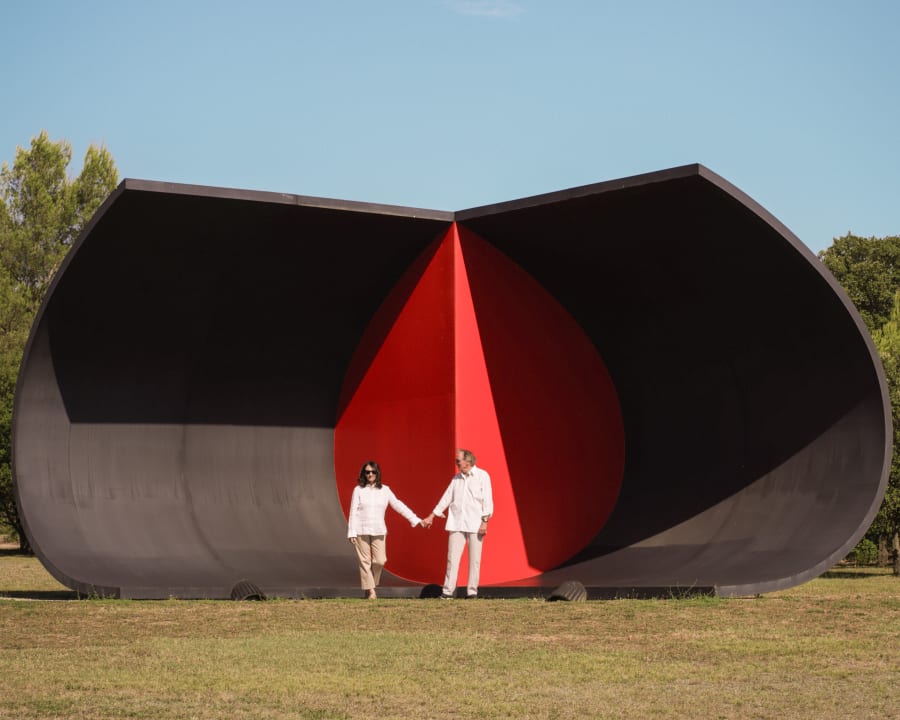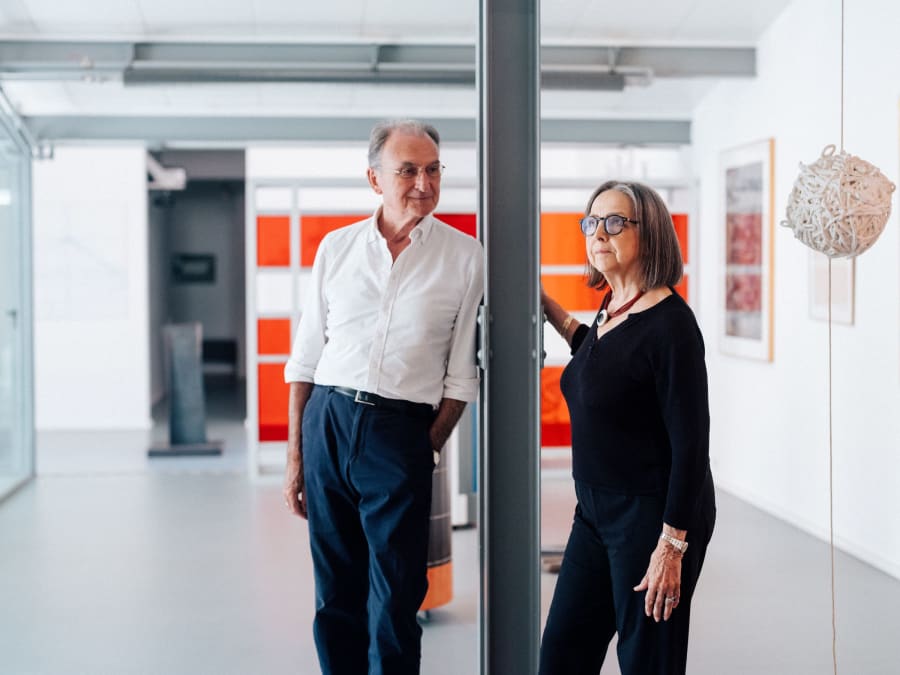‘Don’t trust an art dealer who doesn’t collect,’ a prominent industry figure recently declared. Such a definitive statement is perhaps puzzling – after all, we usually see gallerists as sellers, rather than buyers. But few choose the profession out of pure drive for profit; most are primarily and overwhelmingly passionate lovers of art. So, it follows naturally that those who surround themselves with art in their professional lives often do the same in private.
Some of the world’s most esteemed and largest collections have been built by art dealers. Think of legendary patron Peggy Guggenheim, whose short-lived galleries Guggenheim Jeune in London (1938–1939) and Art of This Century in New York (1942–1947) exhibited some of the 20th century’s most trailblazing artists, from Alexander Calder to Jackson Pollock. Or Ernst Beyeler, who as a gallerist cofounded Art Basel in 1970 and in 1997 launched his world-renowned private foundation, which today is one of Switzerland’s most visited museums. The estate of Ileana Sonnabend, who championed the likes of Jasper Johns and Jannis Kounellis, was estimated at more than USD 800 million when she died in 2007; while the mega-dealer Larry Gagosian’s collection was valued upwards of USD 1 billion in a 2016 report in the Wall Street Journal. Recently, the auctions of the collections of gallerists Barbara Gladstone (1935–2024) and Daniella Luxembourg fetched USD 18.5 million (for 12 lots) and USD 40.4 million (for 15 lots), respectively, shedding light on their prestigious holdings.
To get there, though, is not always straightforward – and some collecting gallerists start with other media. ‘I didn’t grow up in a house filled with art. But I was a creative kid, and so I started making dolls, which led me to acquire porcelain dolls with my mother. That’s the collecting I started with,’ explains Nina Johnson, of the eponymous Miami gallery. Max Mayer, a gallerist based in Düsseldorf, Germany, mentions that his record album collection far exceeds his art collection. ‘I started when I was 16 and now I’m 41, so I’ve accumulated quite a bit,’ he says. Isa Lorenzo and Rachel Rillo, who run Silverlens in Manila and New York, were artists who became dealers (‘because we tried to sell our work and our friends’ work’) and then collectors, Lorenzo explains. Leo Castelli, another towering 20th-century art market figure, started as an insurance salesman in 1930s Trieste, Italy; he purchased his first artwork on his honeymoon (a watercolor by Henri Matisse) with his then-wife, Ileana Sonnabend, before opening his first gallery in 1939 in Paris.
Gallerists who collect benefit from privileged access to an inventory they consider particularly desirable: their own. Many say that they regularly purchase works from themselves – meaning by artists they represent or exhibit at their galleries.
It is, quite simply (but not exclusively), a form of long-term investment. New York’s Andrew Edlin, one of the world’s leading outsider art dealers and owner of the Outsider Art Fair, explains: ‘Nothing is forever: You may represent an artist for a time, and then they may move on to another gallery, usually a bigger one. By owning work by that artist, you can go along for the ride as it escalates in value, which you deserve, because you were crucial in building their reputation and market.’ Johnson agrees: ‘I’m certainly not selling my business to Google anytime soon. So my collection is also what I leave behind to my kids.’ More importantly, she considers buying from her own program ‘a way of showing your artists that you believe in them and in what they’re doing.’ Lorenzo and Rillo, as well as Mayer, also consider it a crucial gesture towards their artists.
But even if you are in charge of selling it, accessing your own material is not always good business. ‘It's quite complex to buy from your own shows, because you can get into a bit of trouble with your favorite collectors. They may think you have kept the best work for yourself,’ notes Roshini Vadehra, of Vadehra Art Gallery in New Delhi. ‘Oftentimes, we end up acquiring the work that nobody wanted,’ Lorenzo says. ‘But interestingly, it’s usually the first piece that the artist made at a breakthrough moment in their practice,’ she adds. Mayer shares a similar view, noting that during exhibitions he often singles out a particular work that stands out to him, yet more often than not, it turns out to be the piece that remains unselected.
Of course, gallerists who collect often buy from their colleagues. This comes with practical advantages – a dealer will understand the intricacies of international shipping, discounts, payment plans, and other concerns they are regularly confronted with, which can make the process easier for all parties. It can also have a positive impact on an artist’s trajectory beyond the immediate income resulting from a sale. At Art Basel Hong Kong in 2024, Lorenzo and Rillo discovered American photographer Antonia Kuo at Chapter NY's booth - and were enthralled. ‘We did a studio visit in New York; we bought something from her last show; and now we’re like, “You know what? We want to bring your work to the Philippines and see if people love it as much as we do.”’ They plan to exhibit Kuo’s work at the gallery’s Manila location in the near future.
Efficient dealers are also deeply embedded in a wide network of art world professionals; selling to a fellow gallerist can therefore increase an artist’s visibility. As someone who regularly invites colleagues and friends to her home, Vadehra explains that her collection ‘is quite visible, so my peers know it will be seen by a wide audience.’ That kind of exposure to curators, collectors, dealers, and journalists can be invaluable.
Naturally, collecting habits can also influence a gallery’s program. Max Mayer says that he has regularly bought work from artists at Kunstakademie Düsseldorf’s student shows, and then incorporated them in his program. He cites young Brazilian draftsman Jorge Loureiro as a recent example. Furthermore, he acknowledges that he may also have been influenced by the collection and relationships of his father, German gallerist Hans Mayer, who is credited as being the first to show Pop Art in Germany. He describes the presence in his program of Japanese artist Ei Arakawa-Nash as ‘an echo’ of his father’s close working relationship with the pioneering multimedia artist Nam June Paik. Andrew Edlin goes even further: For him, what he collects is also what he sells. ‘When I work with an artist, I’m all in. I love the work. What I show at the gallery, I also want to bring home and see on my walls.’
This passion is ultimately what underpins most dealers’ businesses. The first painting Vadehra purchased more than 20 years ago – a watercolor by Anju Dodiya – still hangs in her bedroom. Mayer describes the incomparable feeling he has about a work he made together with Keith Haring as a 6-year-old. Lorenzo and Rillo beam with excitement when they start to discuss their plan to open a non-profit space dedicated to their collection. In these moments, the line between dealer and collector becomes blurry, and all that seems to matter is the joy that both roles elicit. As Nina Johnson puts it: ‘Joy is really why anyone ever did this to begin with.’
Karim Crippa is the Head of Communications of Art Basel Paris and Senior Editor at Art Basel.
Top image: A visitor looking at a work by Joe Coleman at Andrew Edlin's booth at Art Basel Paris 2025.


